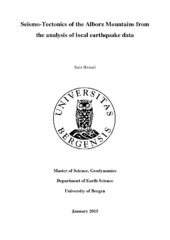Seismo-Tectonics of the Alborz Mountains from the analysis of local earthquake data
Master thesis
Permanent lenke
https://hdl.handle.net/1956/9667Utgivelsesdato
2015-01-26Metadata
Vis full innførselSamlinger
- Department of Earth Science [1033]
Sammendrag
The Alborz range is part of the Alpine- Himalayan Orogenic belt, located in northern Iran, between the South Caspian block and the Central Iranian Block. In this thesis I have chosen an area in Alborz range which has experienced a surprising earthquake (the Rudbar earthquake) that occurred on a fault that was not previously mapped. It could mean that there are other unidentified active faults in Alborz Mountains; therefore I did a comprehensive study of the earthquake activity in this area. For this purpose I went to Iran and got the local seismic data from IIEES and did the following research: - I identified the first P-waves and Sg-phases on my waveforms and I used four different velocity models to locate events in my data set, using single earthquake location method. - I used the travel times of the phases to comparison of existing models and conclusion on crustal thickness. This comparison shows that the velocity model which represents the Moho at a depth of 58±2 km describes structures in the Alborz Mountains better compared to other velocity models. - I also used the travel times of the phases to develop velocity models by improving the existing velocity model, using joint hypocenter and velocity model inversion method. In this thesis I improved the three initial models, but I could not introduce a new model that works better for this study area. - I read amplitudes on vertical- and horizontal components and made vertical to horizontal comparison which shows horizontal components are 1.48 larger than amplitudes on vertical components on average. I used the amplitudes to compute magnitudes and develop a magnitude scale for the study area. - I made the required observations (polarities and amplitude ratios) to determine mechanisms, using FOCMEC and HASH programs. I also used Moment tensor inversion as the third method for calculating the focal mechanisms where full waveforms were used. I used all the above to get an understanding of tectonic setting in study area which represented a complicated tectonic activity in Alborz Mountains.
